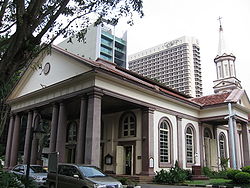Top Qs
Timeline
Chat
Perspective
National monuments of Singapore
From Wikipedia, the free encyclopedia
Remove ads
The National Monuments of Singapore[a] are sites, buildings and structures in Singapore that have been designated by the National Heritage Board (NHB) as possessing exceptional historic, traditional, archaeological, architectural or artistic merit. These monuments are legally protected from demolition due to their cultural and historical significance, including associations with pivotal events such as the Second World War, the independence of Singapore and the nation's early development. The Preservation of Monuments Act empowers the NHB to oversee the preservation of these landmarks and encourages research as well as public engagement with Singapore's architectural heritage.[2]
This article may require cleanup to meet Wikipedia's quality standards. The specific problem is: Information needs to be condensed and some table columns need merging to make the details column more accessible. (July 2025) |

The framework for designating national monuments was established under the Preservation of Monuments Act, enacted in December 1970.[3] The act provided for the identification and legal protection of culturally significant sites, leading to the formation of the Preservation of Monuments Board (PMB) in April 1972. This body was tasked with enforcing the act amidst growing concern over the loss of heritage buildings due to rapid urban redevelopment.[4] By mid-1973, forty sites were shortlisted for preservation and public suggestions were invited to expand the list.[5] The initial batch of eight designated landmarks included the Thong Chai Medical Institution, Armenian Church, St Andrew's Cathedral, Telok Ayer Market, Thian Hock Keng Temple, Sri Mariamman Temple, Fatimah Mosque and the Cathedral of the Good Shepherd.[6] In 2021, amendments were proposed to expand the act's definition to include open spaces, inland waters and any land area associated with human activity, both past and present.[7]
The NHB, a statutory board under the Ministry of Culture, Community and Youth within the Government of Singapore, is responsible for gazetting and maintaining national monuments. As of date, 82 structures have been gazetted of which 75 are formally recognised as national monuments. These include religious sites, civic buildings, marketplaces and other culturally significant landmarks across the island. The most recent addition to the list is the Padang, officially gazetted on National Day in 2022.[8] A comprehensive and regularly updated list of these monuments is accessible via the NHB's heritage portal.[9]
Remove ads
List of national monuments
Summarize
Perspective
Remove ads
Notes
- The addresses of each monument are taken from each monument's entry on ROOTS. Most of their coordinates are taken from OneMap, an interactive map published by the Singapore Land Authority (SLA), except for the following, which were taken from Google Maps as they are not listed on OneMap: Caldwell House
- The following monuments were collectively gazetted as one entry: Caldwell House and Convent of the Holy Infant Jesus Chapel for #23, The Istana and Sri Temasek for #24, The Cenotaph, Lim Bo Seng Memorial, and Tan Kim Seng Fountain as the "Esplanade Park Memorials" for #63, and the Anderson, Cavenagh, and Elgin Bridges as the "Singapore River Bridges" for #73
- An architectural style popularised in the Edwardian Era featuring red bricks as the 'blood' and plaster layovers as the 'bandage'
- These bridges include a timber bridge during the 1820s, a temporary wooden drawbridge called the Presentment Bridge (also known as the Jackson Bridge), and the Thomson Bridge, which replaced the Presentment Bridge in 1844. The Thomson Bridge was subsequently demolished in 1862 for the first Elgin Bridge.
- Six of its blocks were collectively gazetted as a national monument, although still counted as one building: Oei Tiong Ham Building, Manasseh Meyer Building, Eu Tong Sen Building, Federal Building, C. J. Koh Law Library, and Li Ka Shing Building.[39]
- 11 structures within the fort were also collectively gazetted as part of Fort Siloso: 19th century casemates, four gun emplacements, three tunnel complexes, the Battery Command Post, Fire Director Tower, and the former Sergeants’ Mess and Officers’ Mess
Remove ads
References
External links
Wikiwand - on
Seamless Wikipedia browsing. On steroids.
Remove ads














































































